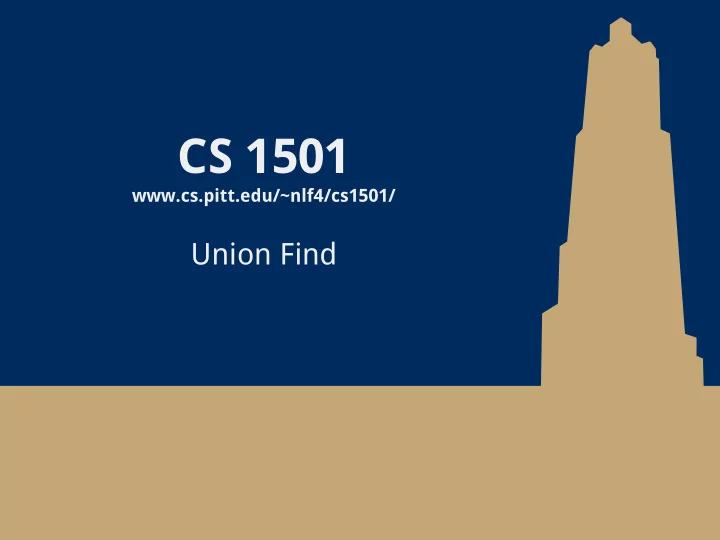

CS 1501 www.cs.pitt.edu/~nlf4/cs1501/ Union Find
Dynamic connectivity problem For a given graph G, can we determine whether or not two ● vertices are connected in G? Can also be viewed as checking subset membership ● ● Important for many practical applications We will solve this problem using a union/find data structure ● 2
A simple approach ● Have an id array simply store the component id for each item in the union/find structure How do we determine if two vertices are connected? ○ How do we establish the connected components? ○ Add graph edges one at a time to UF data structure using ■ union operations 3
Example U(2, 0) 1 4 U(4, 7) U(1, 2) 0 2 5 7 U(3, 2) U(4, 5) U(5, 7) 3 6 U(6, 3) 0 1 2 3 4 5 6 7 ID: 0 1 6 3 6 3 1 3 6 0 1 2 6 3 4 4 5 6 4 7 4
Analysis of our simple approach Runtime? ● ○ To find if two vertices are connected? ○ For a union operation? 5
Union Find API Initialize with n items numbered 0 to n-1 Connect p with q UF (int n) void union(int p, int q) Return id of the connected component that p is in int find (int p) boolean connected (int p, int q) int count() True if p and q are connected Number of connected components 6
Covering the basics public int count() { return count; } public boolean connected(int p, int q) { return find(p) == find(q); } 7
Implementing the Fast-Find approach public UF(int n) { count = n; id = new int[n]; for (int i = 0; i < n; i++) { id[i] = i; } } public int find(int p) { return id[p]; } public void union(int p, int q) { int pID = find(p), qID = find(q); if (pID == qID) return; for(int i = 0; i < id.length; i++) if (id[i] == pID) id[i] = qID; count--; } 8
Kruskal’s algorithm ● With this knowledge of union/find, how, exactly can it be used as a part of Kruskal’s algorithm? What is the runtime of Kruskal’s algorithm? ○ 9
Kruskal's example revisited 0 PQ: 6 5 1: (0, 2) 1 1 3 2: (3, 5) 3: (1, 4) 5 5 2 4: (2, 5) 3 2 5: (2, 3) 6 4 5: (0, 3) 4 5 5: (1, 2) 6 6: (0, 1) 6: (2, 4) 6: (4, 5) 10
Can we improve on union()’s runtime? What if we store our connected components as a forest of ● trees? Each tree representing a different connected component ○ Every time a new connection is made, we simply make one ○ tree the child of another 11
Tree example 1 4 3 0 2 5 7 1 3 6 2 7 0 1 2 3 4 5 6 7 12
Implementation using the same id array public int find(int p) { while (p != id[p]) p = id[p]; return p; } public void union(int p, int q) { int i = find(p); int j = find(q); if (i == j) return; id[i] = j; count--; } 13
Forest of trees implementation analysis Runtime? ● ○ find(): ■ Bound by the height of the tree ○ union(): ■ Bound by the height of the tree ● What is the max height of the tree? Can we modify our approach to cap its max height? ○ 14
Weighted tree example 1 4 0 2 5 7 3 6 2 7 0 1 2 3 4 5 6 7 15
Weighted trees public UF(int n) { count = n; id = new int[n]; sz = new int[n]; for (int i = 0; i < n; i++) { id[i] = i; sz[i] = 1; } } public void union(int p, int q) { int i = find(p), j = find(q); if (i == j) return; if (sz[i] < sz[j]) { id[i] = j; sz[j] += sz[i]; } else { id[j] = i; sz[i] += sz[j]; } count--; } 16
Weighted tree approach analysis Runtime? ● ○ find()? ○ union()? Can we do any better? ● 17
Kruskal’s algorithm, once again ● What is the runtime of Kruskal’s algorithm?? 18
Path Compression find(4) find(0) 4 0 3 5 2 2 1 6 5 4 0 0 4 7 19
Recommend
More recommend